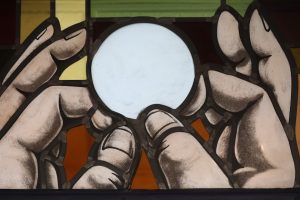“The Priest genuflects, takes the host, and holding it slightly raised above the paten or above the chalice, while facing the people, says aloud: “Behold, the Lamb of God, behold him who takes away the sins of the world. Blessed are those called to the supper of the Lamb.”

So reads the Roman Missal as we prepare for Communion with the Body of Christ in the Eucharist.
Lent leads us to Holy Week and the Paschal Mystery. During the Eucharistic Revival, this familiar Mass text is worth a closer look.
The two sentences in the invitation to look upon the Lamb of God are straight out of Scripture, though from importantly different sources. The first is from John the Baptist, whose mission was to point out the Messiah, the Anointed One. As the Gospel records, John the Baptist saw Jesus coming toward him and said: “Behold, the Lamb of God, who takes away the sin of the world.” And then the following day — significantly, the third day featured in this Gospel passage, a subtle reference to the Resurrection — two of John’s own disciples were with him, “and as he watched Jesus walk by he said, ‘Behold, the Lamb of God.’”
The title “Lamb of God,” of course, links to the Paschal lamb from the book of Exodus. The blood of this lamb was to mark the doorposts and lintel of the Israelites who partake of the flesh of the lamb, sparing them from the 10th plague on Egypt — the death of the firstborn in every household.
Tracing the deep and intricate historical and theological connections of the “Lamb who was slain” is beyond this brief column. But the record of the Passover event was decisive in shaping Christian understanding of the death and resurrection of Jesus: The Lamb of God is the eternal only-begotten Son of God, whose freely-offered sacrificial death destroys the power of sin and death. Christians consume the Body of the Lamb of God and drink of his Blood and thus share in the life he brings beyond death.
That brief outline summarizes the first sentence of that invitation at Mass. But the second line is richer still: “Blessed are those called to the Supper of the Lamb.”

It is natural and correct to connect the liturgy’s “Supper of the Lamb” with the Last Supper; even the celebration of Holy Thursday is titled “The Mass of the Lord’s Supper.” We are blessed indeed to be able to share in this eucharistic banquet and receive the glorified Body and Blood of Jesus himself, uniting us to him and to one another in a communion of life and love. Yet there is another related phrase like this in Scripture, from the Book of Revelation (19:6-9).
There we read: “The Lord has established his reign … let us rejoice and be glad and give him glory. For the wedding day of the Lamb has come; his bride has made herself ready. … Then the angel said to me, ‘Write this: “Blessed are those who have been called to the wedding feast of the Lamb.”’
At Mass, then, we are linked not only to past events — the Exodus and the Paschal Mystery of Jesus’ dying and rising — but also to the future life of glory they foreshadow and make possible. St. Paul uses this image of Jesus the Bridegroom and the Church as his bride because this relationship is the prototype for the sacrament of marriage: a perfect interpersonal communion of life and love expressed through the body (to borrow the words of St. John Paul II’s “theology of the body”).
The Eucharist is the fullness of that communion, where we are joined to the life and love of God through the risen Body of Christ. Mass is the “wedding feast of the Lamb.” We are made one with Jesus, and one another, in his Body. We receive him, and he receives us, in a communion of love. Like a wedding, it establishes an enduring relationship but does not exhaust that relationship. It is only the beginning of “all the days of my life.”
This leads us to yet one more element. After the Resurrection, John’s Gospel tells us, Jesus appeared to the Eleven on the shore. Unrecognized by them, this stranger directed them to cast their nets on the other side of the boat, resulting in a catch of overwhelming abundance. Overjoyed at now knowing their Lord, they bring the fish to shore to find that Jesus has already prepared for them a meal of bread and fish. (In Greek, fish is “ikhthus,” which early Christians adopted as an acronym for “Iēsoûs Khrīstós, Theoû Huiós, Sōtḗr” (Jesus Christ, Son of God, Savior). It is John’s way to indicate that the eucharistic bread is truly the saving Body of Christ.
When the Eleven come to shore, Jesus invites them: “Come, have breakfast.” Supper is the meal at the end of the day when the work is over. Breakfast begins a new day with all that lies ahead. John tells us that the Eucharist is this sacred nourishment, only the beginning of the new day that has no end. That journey is not yet complete, but we have set out with Jesus at our side.
Blessed are those called to the Supper of the Lamb: the Lord’s Supper, the wedding feast and breaking our fast to share already the beginning of the endless day of joy.
Father Tom Knoblach is pastor of Sacred Heart in Sauk Rapids and Annunciation in Mayhew Lake. He also serves as consultant for health care ethics for the Diocese of St. Cloud.






















